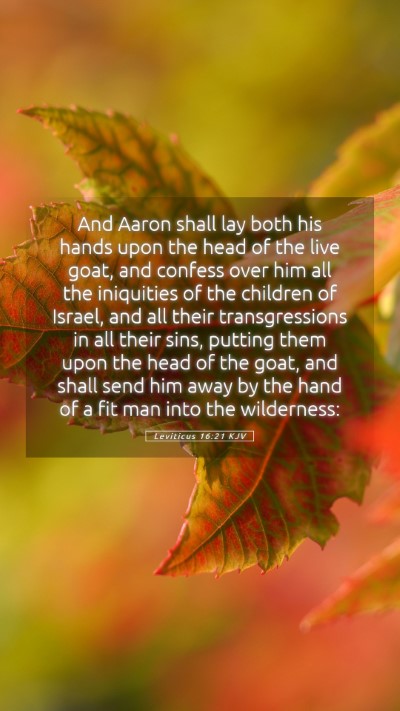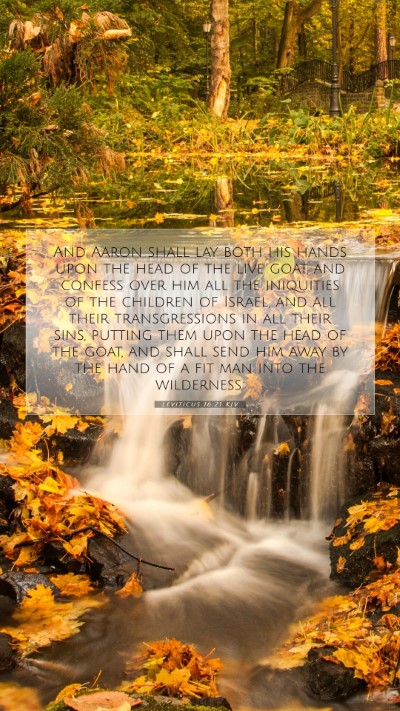Understanding Leviticus 16:21
Verse Text: "And Aaron shall lay both his hands upon the head of the live goat, and confess over him all the iniquities of the children of Israel, and all their transgressions in all their sins, putting them upon the head of the goat, and shall send him away by the hand of a fit man into the wilderness."
Bible Verse Meaning
This verse describes the ritual of the scapegoat during the Day of Atonement, a significant aspect of the ancient Israelite sacrificial system. It illustrates the process through which the sins of the people were symbolically transferred to the goat, which was then sent away into the wilderness, signifying the removal of sin from the community.
Commentary Insights
-
Matthew Henry:
Henry emphasizes the deep symbolism in this act. The laying on of hands represents identification with the sins of the people, showcasing the gravity of sin and the necessity for atonement. The goat, as the 'scapegoat', embodies the isolation and removal of sin, highlighting God's mercy as well as His justice.
-
Albert Barnes:
Barnes notes the significance of the 'fit man' who leads the goat into the wilderness, indicating the idea that it is not just about confession but also about the complete removal of sin from the community. This ritual serves as a foreshadowing of Christ's ultimate sacrifice, which would bear and remove the sins of humanity.
-
Adam Clarke:
Clarke elaborates on the procedure and its implications, stressing that the confession of sins is a vital step in the repentance process. The act of sending the goat away signifies the hope for forgiveness and the erasure of guilt, and serves as a powerful ritual for the community to understand the consequences of sin and the need for divine forgiveness.
Biblical Exegesis
The ritual described in Leviticus 16:21 embodies the theological concepts of sin, atonement, and redemption. By laying hands on the goat, Aaron symbolically transferred the sins of Israel onto it, representing a communal acknowledgment of guilt and the need for spiritual cleansing.
Historical Context
Understanding this ritual also requires awareness of its historical context:
- The Day of Atonement (Yom Kippur) was the holiest day in the Jewish calendar, serving as a day for national atonement and renewal.
- This ritual reflects ancient Israel's understanding of sin and purity, where physical symbols were used to convey deep spiritual truths.
Applications for Today
While the specific ritual may not be practiced today, the underlying themes remain relevant:
- Confession and Repentance: Acknowledging our sins is essential for spiritual growth and integrity.
- Need for Forgiveness: Understanding that forgiveness is a process and a gift from God can guide daily life choices.
- Hope and Renewal: Like the goat sent into the wilderness, we can experience the liberation that comes from being forgiven and set free from our pasts.
Cross References
- Isaiah 53:6: "All we like sheep have gone astray; we have turned everyone to his own way; and the LORD hath laid on him the iniquity of us all." - This points to the ultimate sacrificial atonement fulfilled in Christ.
- Hebrews 9:26: "...but now once in the end of the world hath he appeared to put away sin by the sacrifice of himself." - This emphasizes the completeness of Christ's atonement as the final scapegoat.
- Psalm 103:12: "As far as the east is from the west, so far hath he removed our transgressions from us." - This illustrates the spiritual principle of sins being removed from us through God's mercy.
Conclusion
Leviticus 16:21 serves as a foundational scripture not only in the Old Testament context but also with profound implications for New Testament theology regarding atonement and forgiveness through Jesus Christ. As believers, understanding this ritual reinforces the significance of confession, the necessity for atonement, and the hope found in God's redemptive plan.
For those engaging in bible study, the insights gathered from this verse support the exploration of biblical themes of sin, forgiveness, and redemption. Engaging with such bible study resources and materials can deepen understanding of Scripture and its relevance in daily life.


